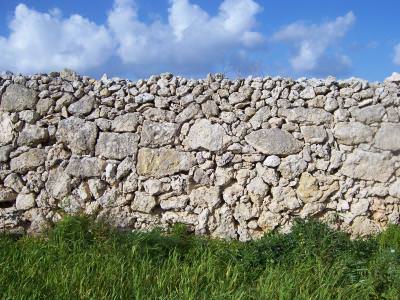Rubble masonry
Rubble masonry, also known as rubblework, is the use of undressed, rough stone, generally for the construction of walls.
The most basic form of rubble masonry is dry-stone rubble walls which are very common in rural locations and popular with landscapers looking for a traditional aesthetic. The rough, unhewn stones are piled on top of one another without mortar, and are often laid in irregular horizontal courses.
Alternatively, the stones can be bound with cement or lime mortar, although in this case, a greater degree of stone selection may be required to avoid excessively wide mortar joints. Stones can be bonded by laying longer ones both along the face and oriented lengthwise across the depth of the wall. Selected stones are laid to form roughly square angles at quoins and around openings.
Polygonal rubble walling is where stones are split-faced and roughly dressed to suit a specific pattern or design. Random rubble walls involve stones of varying sizes and joint widths with small wedge-shaped fillets bedded into the mortar between them.
Rubble masonry can also be used as the outer surface of a wall, particularly common in medieval cathedrals and historic buildings, and as a core infill between external and internal wall faces.
[edit] Related articles on Designing Buildings Wiki
Featured articles and news
One of the most impressive Victorian architects. Book review.
RTPI leader to become new CIOB Chief Executive Officer
Dr Victoria Hills MRTPI, FICE to take over after Caroline Gumble’s departure.
Social and affordable housing, a long term plan for delivery
The “Delivering a Decade of Renewal for Social and Affordable Housing” strategy sets out future path.
A change to adoptive architecture
Effects of global weather warming on architectural detailing, material choice and human interaction.
The proposed publicly owned and backed subsidiary of Homes England, to facilitate new homes.
How big is the problem and what can we do to mitigate the effects?
Overheating guidance and tools for building designers
A number of cool guides to help with the heat.
The UK's Modern Industrial Strategy: A 10 year plan
Previous consultation criticism, current key elements and general support with some persisting reservations.
Building Safety Regulator reforms
New roles, new staff and a new fast track service pave the way for a single construction regulator.
Architectural Technologist CPDs and Communications
CIAT CPD… and how you can do it!
Cooling centres and cool spaces
Managing extreme heat in cities by directing the public to places for heat stress relief and water sources.
Winter gardens: A brief history and warm variations
Extending the season with glass in different forms and terms.
Restoring Great Yarmouth's Winter Gardens
Transforming one of the least sustainable constructions imaginable.
Construction Skills Mission Board launch sector drive
Newly formed government and industry collaboration set strategy for recruiting an additional 100,000 construction workers a year.
New Architects Code comes into effect in September 2025
ARB Architects Code of Conduct and Practice available with ongoing consultation regarding guidance.
Welsh Skills Body (Medr) launches ambitious plan
The new skills body brings together funding and regulation of tertiary education and research for the devolved nation.
Paul Gandy FCIOB announced as next CIOB President
Former Tilbury Douglas CEO takes helm.























